TOYOTA PRIUS PLUG-IN HYBRID 2018 Owners Manual
Manufacturer: TOYOTA, Model Year: 2018, Model line: PRIUS PLUG-IN HYBRID, Model: TOYOTA PRIUS PLUG-IN HYBRID 2018Pages: 772, PDF Size: 107.88 MB
Page 371 of 772
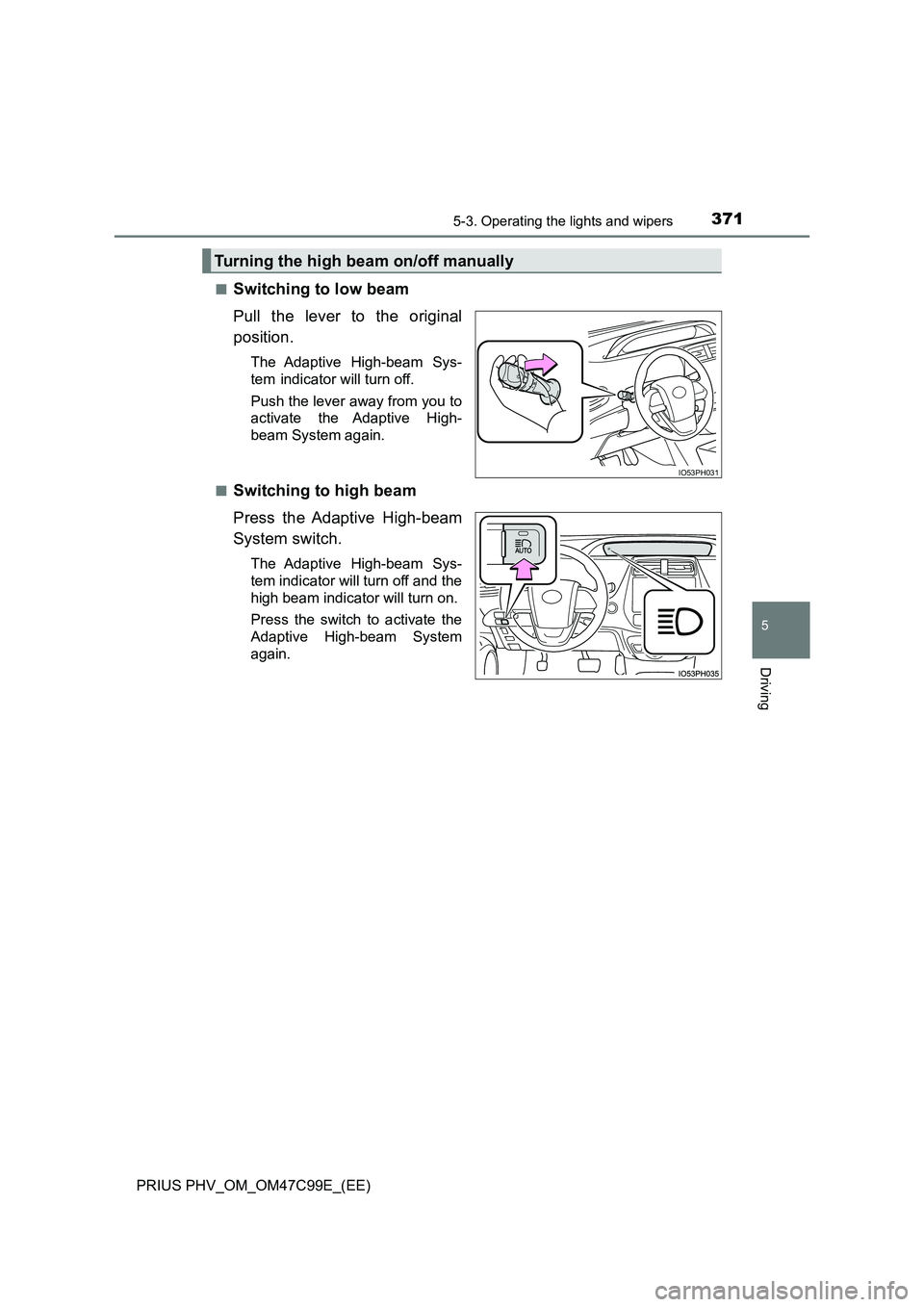
3715-3. Operating the lights and wipers
PRIUS PHV_OM_OM47C99E_(EE)
5
Driving
■Switching to low beam
Pull the lever to the original
position.
The Adaptive High-beam Sys-
tem
indicator will turn off.
Push the lever away from you to
activate the Adaptive High-
beam System again.
■
Switching to high beam
Press the Adaptive High-beam
System switch.
The Adaptive High-beam Sys-
tem indicator will turn off and the
high beam indicator will turn on.
Press the switch to activate the
Adaptive High-beam System
again.
Turning the high beam on/off manually
IO53PH031
Page 372 of 772
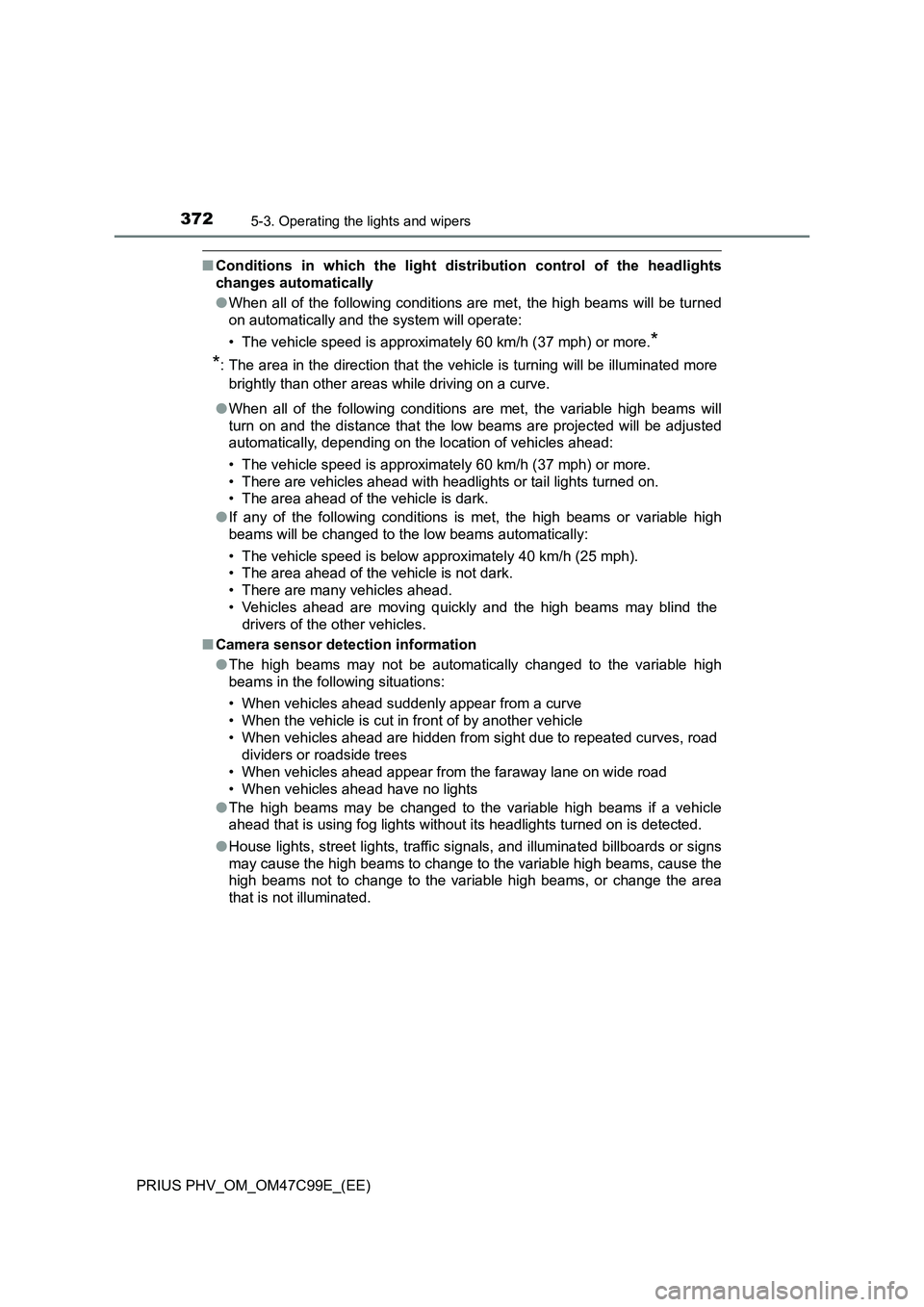
3725-3. Operating the lights and wipers
PRIUS PHV_OM_OM47C99E_(EE)
■Conditions in which the light distribution control of the headlights
changes automatically
●When all of the following conditions are met, the high beams will be turned
on automatically and the system will operate:
• The vehicle speed is approximately 60 km/h (37 mph) or more.
*
*
: The area in the direction that the vehicle is turning will be illuminated more
brightly than other areas while driving on a curve.
●When all of the following conditions are met, the variable high beams will
turn on and the distance that the low beams are projected will be adjusted
automatically, depending on the location of vehicles ahead:
• The vehicle speed is approximately 60 km/h (37 mph) or more.
• There are vehicles ahead with headlights or tail lights turned on.
• The area ahead of the vehicle is dark.
●If any of the following conditions is met, the high beams or variable high
beams will be changed to the low beams automatically:
• The vehicle speed is below approximately 40 km/h (25 mph).
• The area ahead of the vehicle is not dark.
• There are many vehicles ahead.
• Vehicles ahead are moving quickly and the high beams may blind the
drivers of the other vehicles.
■Camera sensor detection information
●The high beams may not be automatically changed to the variable high
beams in the following situations:
• When vehicles ahead suddenly appear from a curve
• When the vehicle is cut in front of by another vehicle
• When vehicles ahead are hidden from sight due to repeated curves, road
dividers or roadside trees
• When vehicles ahead appear from the faraway lane on wide road
• When vehicles ahead have no lights
●The high beams may be changed to the variable high beams if a vehicle
ahead that is using fog lights without its headlights turned on is detected.
●House lights, street lights, traffic signals, and illuminated billboards or signs
may cause the high beams to change to the variable high beams, cause the
high beams not to change to the variable high beams, or change the area
that is not illuminated.
Page 373 of 772
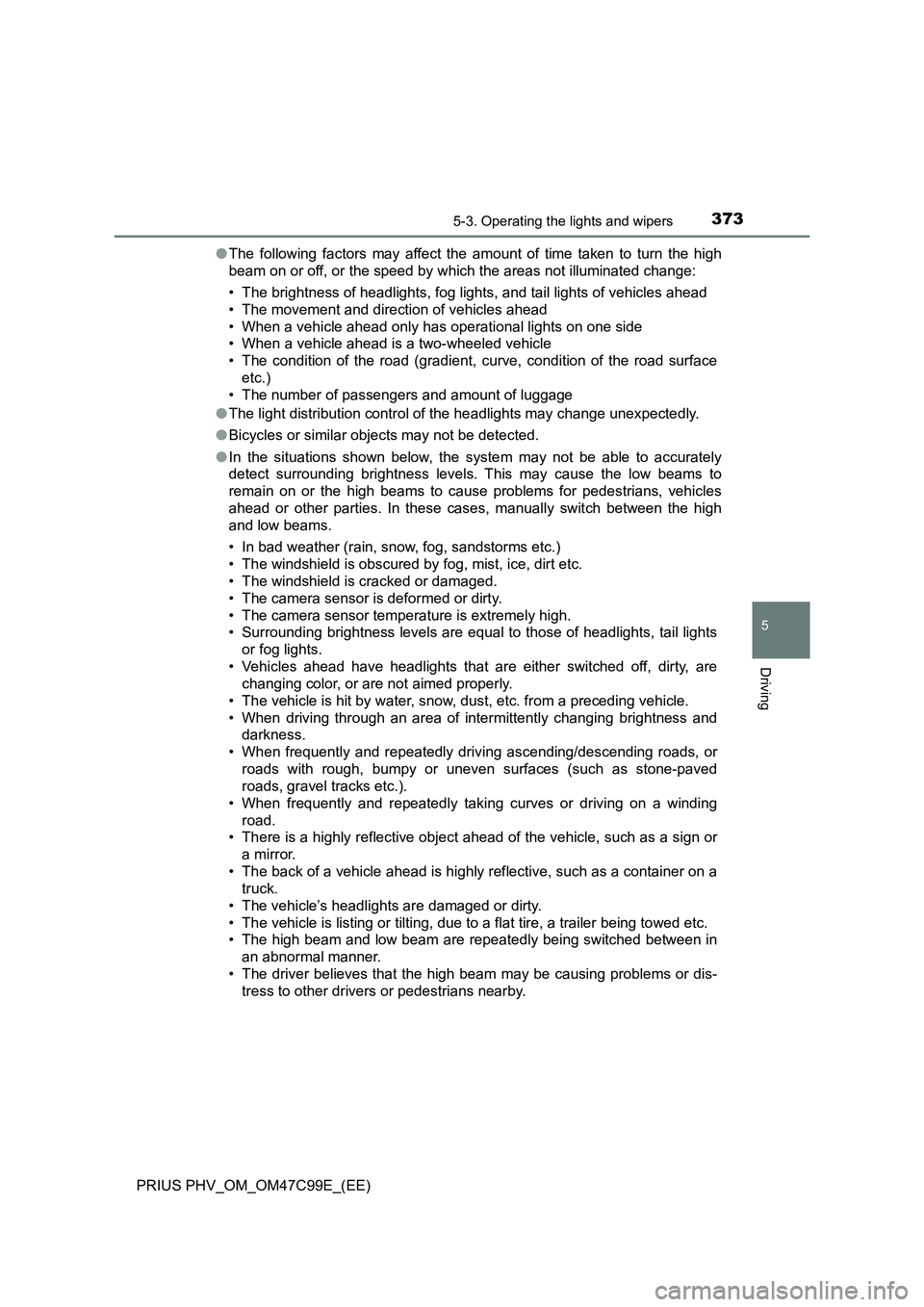
3735-3. Operating the lights and wipers
PRIUS PHV_OM_OM47C99E_(EE)
5
Driving
●The following factors may affect the amount of time taken to turn the high
beam on or off, or the speed by which the areas not illuminated change:
• The brightness of headlights, fog lights, and tail lights of vehicles ahead
• The movement and direction of vehicles ahead
• When a vehicle ahead only has operational lights on one side
• When a vehicle ahead is a two-wheeled vehicle
• The condition of the road (gradient, curve, condition of the road surface
etc.)
• The number of passengers and amount of luggage
●The light distribution control of the headlights may change unexpectedly.
●Bicycles or similar objects may not be detected.
●In the situations shown below, the system may not be able to accurately
detect surrounding brightness levels. This may cause the low beams to
remain on or the high beams to cause problems for pedestrians, vehicles
ahead or other parties. In these cases, manually switch between the high
and low beams.
• In bad weather (rain, snow, fog, sandstorms etc.)
• The windshield is obscured by fog, mist, ice, dirt etc.
• The windshield is cracked or damaged.
• The camera sensor is deformed or dirty.
• The camera sensor temperature is extremely high.
• Surrounding brightness levels are equal to those of headlights, tail lights
or fog lights.
• Vehicles ahead have headlights that are either switched off, dirty, are
changing color, or are not aimed properly.
• The vehicle is hit by water, snow, dust, etc. from a preceding vehicle.
• When driving through an area of intermittently changing brightness and
darkness.
• When frequently and repeatedly driving ascending/descending roads, or
roads with rough, bumpy or uneven surfaces (such as stone-paved
roads, gravel tracks etc.).
• When frequently and repeatedly taking curves or driving on a winding
road.
• There is a highly reflective object ahead of the vehicle, such as a sign or
a mirror.
• The back of a vehicle ahead is highly reflective, such as a container on a
truck.
• The vehicle’s headlights are damaged or dirty.
• The vehicle is listing or tilting, due to a flat tire, a trailer being towed etc.
• The high beam and low beam are repeatedly being switched between in
an abnormal manner.
• The driver believes that the high beam may be causing problems or dis-
tress to other drivers or pedestrians nearby.
Page 374 of 772
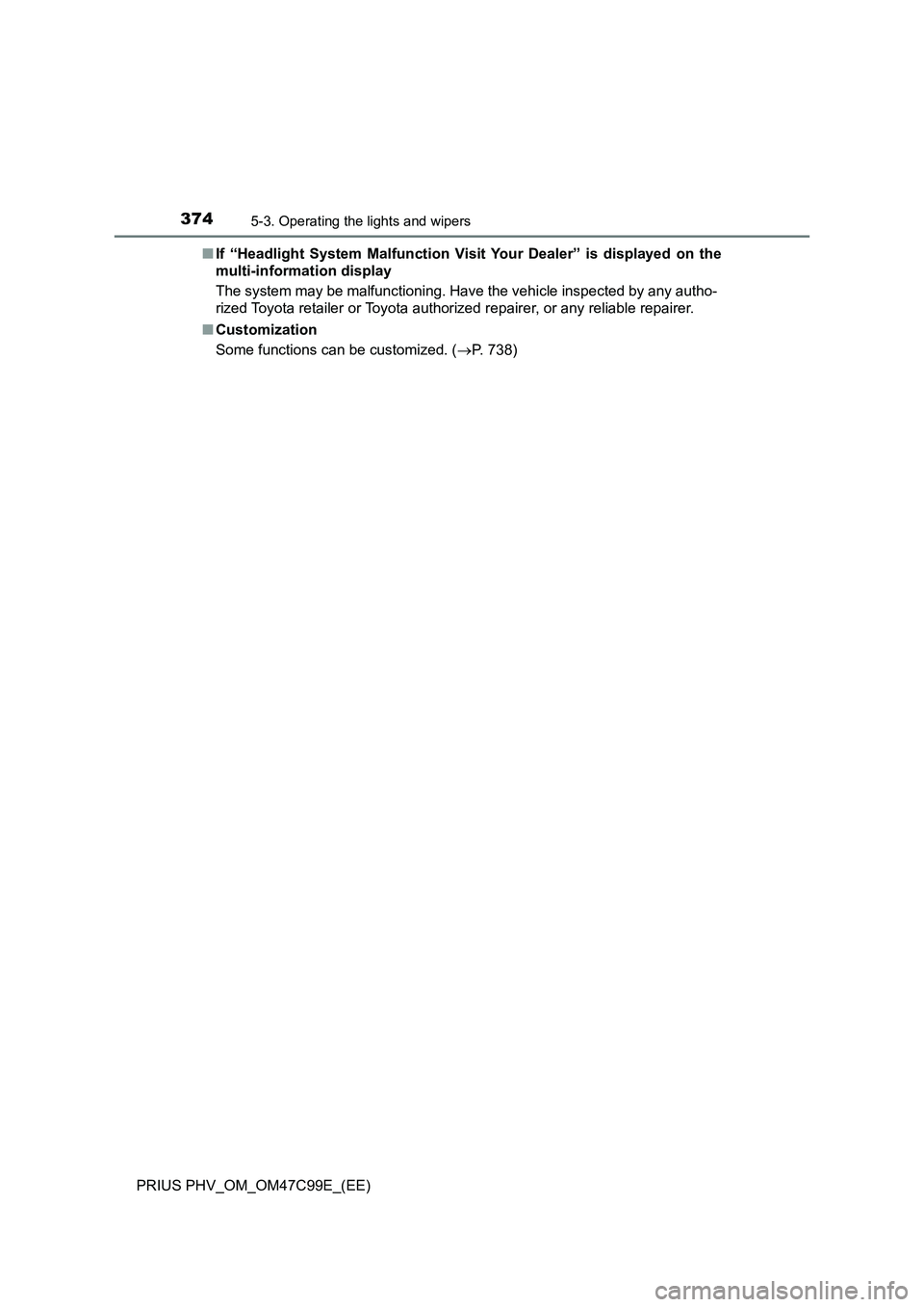
3745-3. Operating the lights and wipers
PRIUS PHV_OM_OM47C99E_(EE)■If “Headlight System Malfunction Visit Your Dealer” is displayed on the
multi-information display
The system may be malfunctioning. Have the vehicle inspected by any autho-
rized Toyota retailer or Toyota authorized repairer, or any reliable repairer.
■Customization
Some functions can be customized. (P. 738)
Page 375 of 772
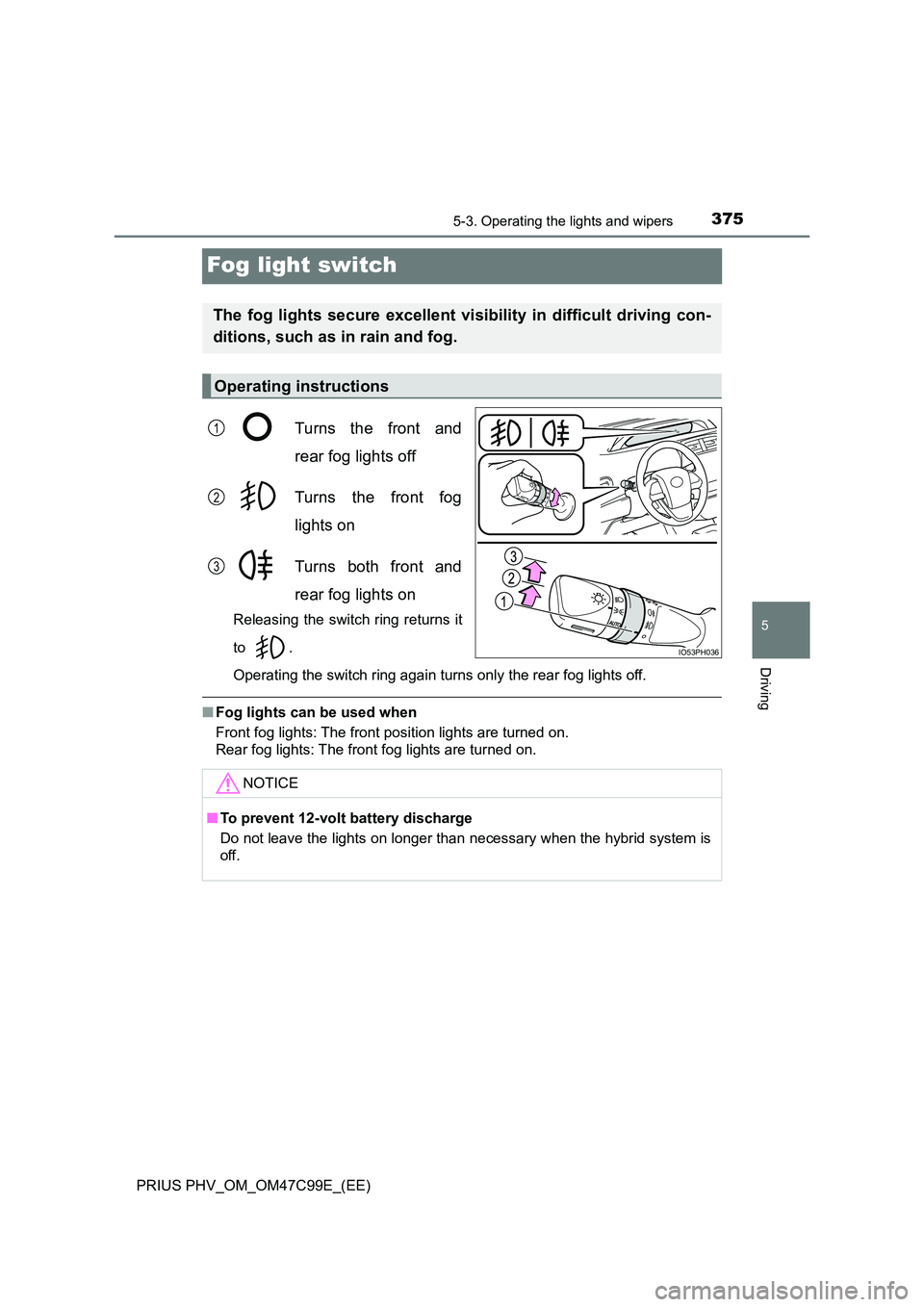
3755-3. Operating the lights and wipers
PRIUS PHV_OM_OM47C99E_(EE)
5
Driving
Fog light switch
Turns the front and
rear fog lights off
Turns the front fog
lights on
Turns both front and
rear fog lights on
Releasing the switch ring returns it
to .
Operating the switch ring again turns only the rear fog lights off.
■ Fog lights can be used when
Front fog lights: The front position lights are turned on.
Rear fog lights: The front fog lights are turned on.
The fog lights secure excellent visibility in difficult driving con-
ditions, such as in rain and fog.
Operating instructions
IO53PH036
1
2
3
NOTICE
■ To prevent 12-volt battery discharge
Do not leave the lights on longer than necessary when the hybrid system is
off.
Page 376 of 772
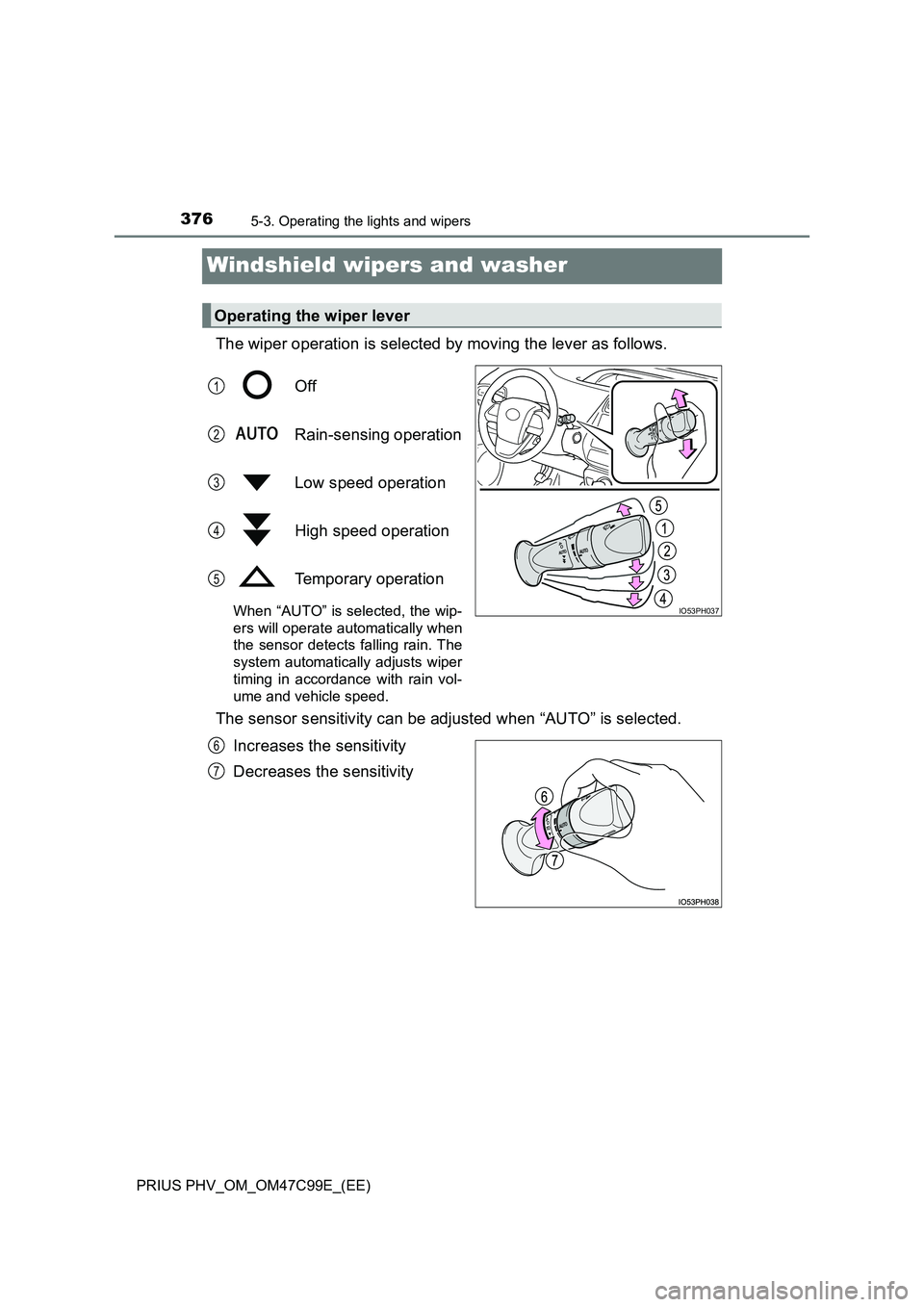
3765-3. Operating the lights and wipers
PRIUS PHV_OM_OM47C99E_(EE)
Windshield wipers and washer
The wiper operation is selected by moving the lever as follows.
Off
Rain-sensing operation
Low speed operation
High speed operation
Temporary operation
When “AUTO” is selected, the wip-
ers will operate automatically when
the sensor detects falling rain. The
system automatically adjusts wiper
timing in accordance with rain vol-
ume and vehicle speed.
The sensor sensitivity can be adjusted when “AUTO” is selected.
Increases the sensitivity
Decreases the sensitivity
Operating the wiper lever
IO53PH037
1
2
3
4
5
6
7
Page 377 of 772
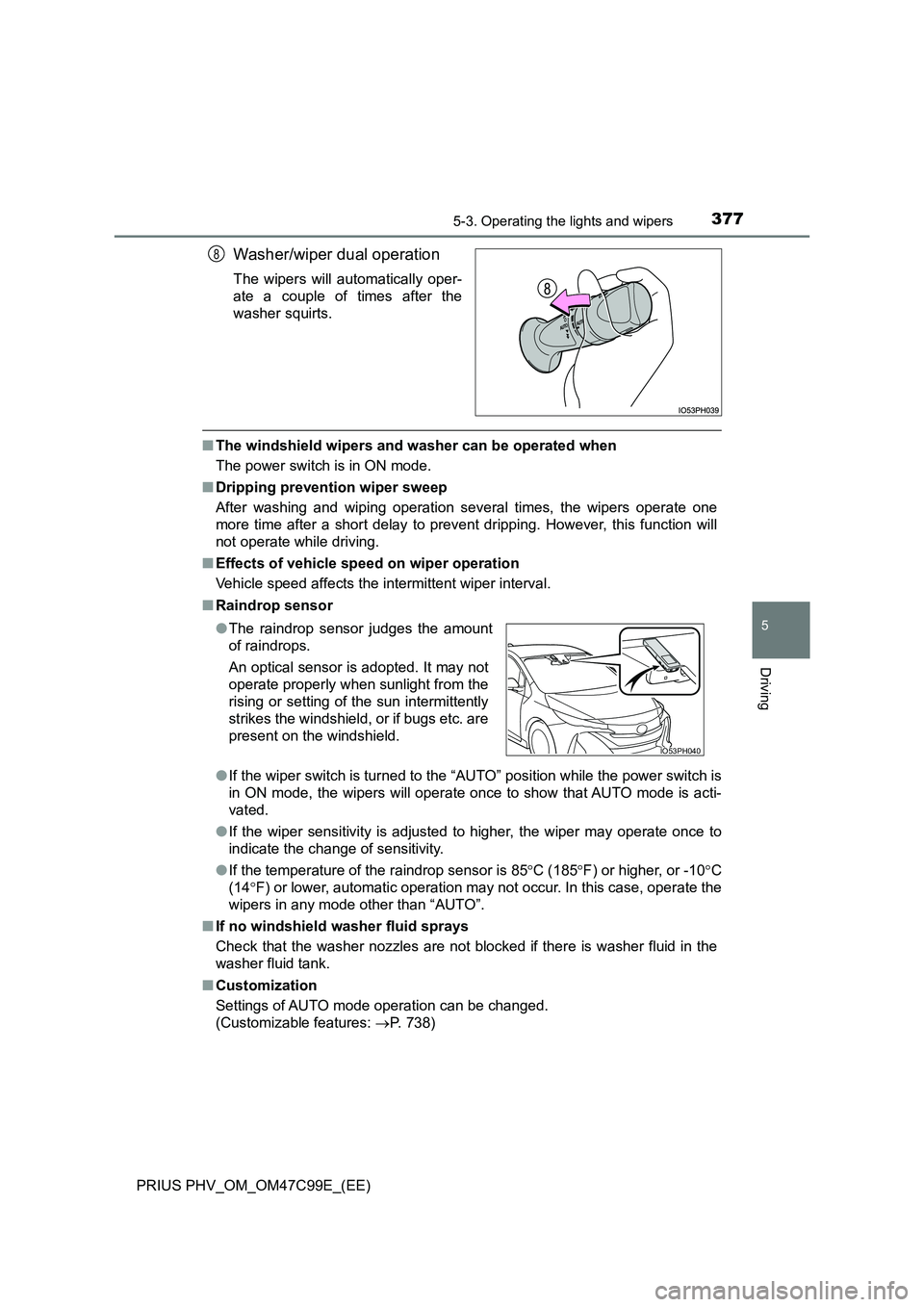
3775-3. Operating the lights and wipers
PRIUS PHV_OM_OM47C99E_(EE)
5
Driving
Washer/wiper dual operation
The wipers will automatically oper-
ate a couple of times after the
washer squirts.
■ The windshield wipers and washer can be operated when
The power switch is in ON mode.
■ Dripping prevention wiper sweep
After washing and wiping operation se veral times, the wipers operate one
more time after a short delay to prevent dripping. However, this function will
not operate while driving.
■ Effects of vehicle speed on wiper operation
Vehicle speed affects the intermittent wiper interval.
■ Raindrop sensor
● If the wiper switch is turned to the “AUTO” position while the power switch is
in ON mode, the wipers will operate once to show that AUTO mode is acti-
vated.
● If the wiper sensitivity is adjusted to higher, the wiper may operate once to
indicate the change of sensitivity.
● If the temperature of the raindrop sensor is 85C (185F) or higher, or -10C
(14 F) or lower, automatic operation may not occur. In this case, operate the
wipers in any mode other than “AUTO”.
■ If no windshield washer fluid sprays
Check that the washer nozzles are not blocked if there is washer fluid in the
washer fluid tank.
■ Customization
Settings of AUTO mode operation can be changed.
(Customizable features: P. 738)
8
●The raindrop sensor judges the amount
of raindrops.
An optical sensor is adopted. It may not
operate properly when sunlight from the
rising or setting of the sun intermittently
strikes the windshield, or if bugs etc. are
present on the windshield.IO53PH040
Page 378 of 772
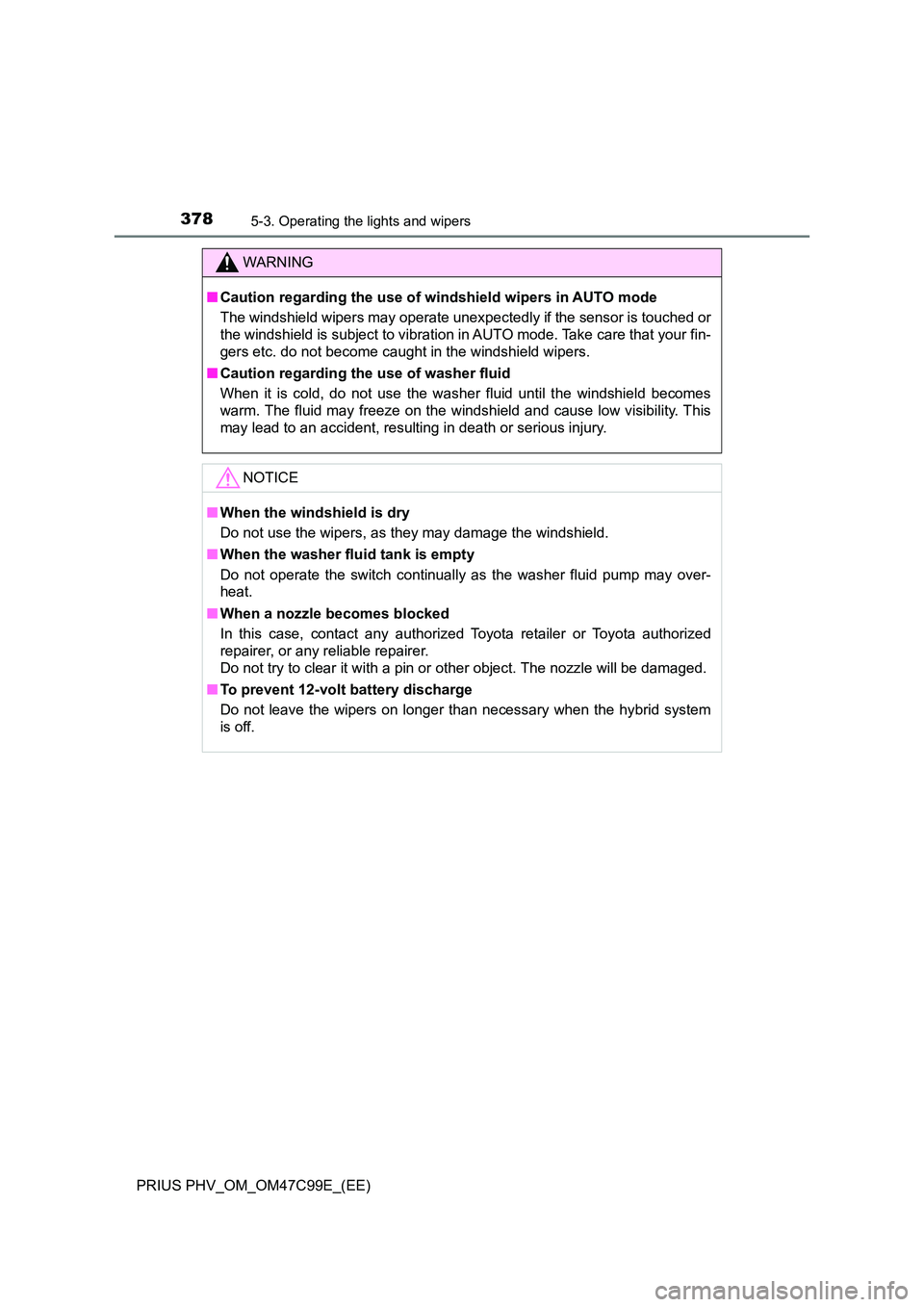
3785-3. Operating the lights and wipers
PRIUS PHV_OM_OM47C99E_(EE)
WARNING
■Caution regarding the use of windshield wipers in AUTO mode
The windshield wipers may operate unexpectedly if the sensor is touched or
the windshield is subject to vibration in AUTO mode. Take care that your fin-
gers etc. do not become caught in the windshield wipers.
■ Caution regarding the use of washer fluid
When it is cold, do not use the washer fluid until the windshield becomes
warm. The fluid may freeze on the windshield and cause low visibility. This
may lead to an accident, resulting in death or serious injury.
NOTICE
■ When the windshield is dry
Do not use the wipers, as they may damage the windshield.
■ When the washer fluid tank is empty
Do not operate the switch continually as the washer fluid pump may over-
heat.
■ When a nozzle becomes blocked
In this case, contact any authorized Toyota retailer or Toyota authorized
repairer, or any reliable repairer.
Do not try to clear it with a pin or other object. The nozzle will be damaged.
■ To prevent 12-volt battery discharge
Do not leave the wipers on longer than necessary when the hybrid system
is off.
Page 379 of 772
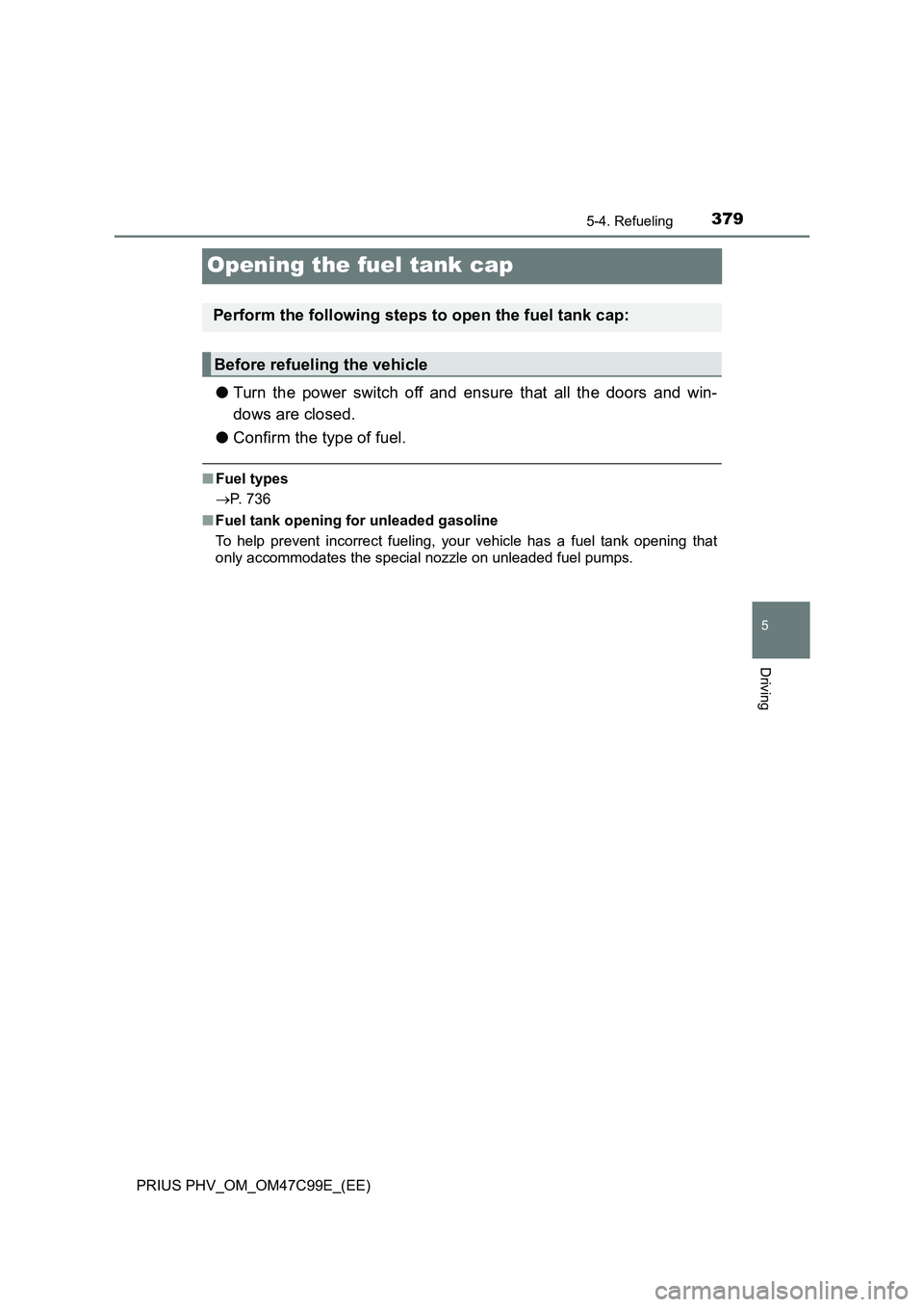
3795-4. Refueling
PRIUS PHV_OM_OM47C99E_(EE)
5
Driving
Opening the fuel tank cap
●Turn the power switch off and ensure that all the doors and win-
dows are closed.
●Confirm the type of fuel.
■Fuel types
P. 736
■Fuel tank opening for unleaded gasoline
To help prevent incorrect fueling, your vehicle has a fuel tank opening that
only accommodates the special nozzle on unleaded fuel pumps.
Perform the following steps to open the fuel tank cap:
Before refueling the vehicle
Page 380 of 772
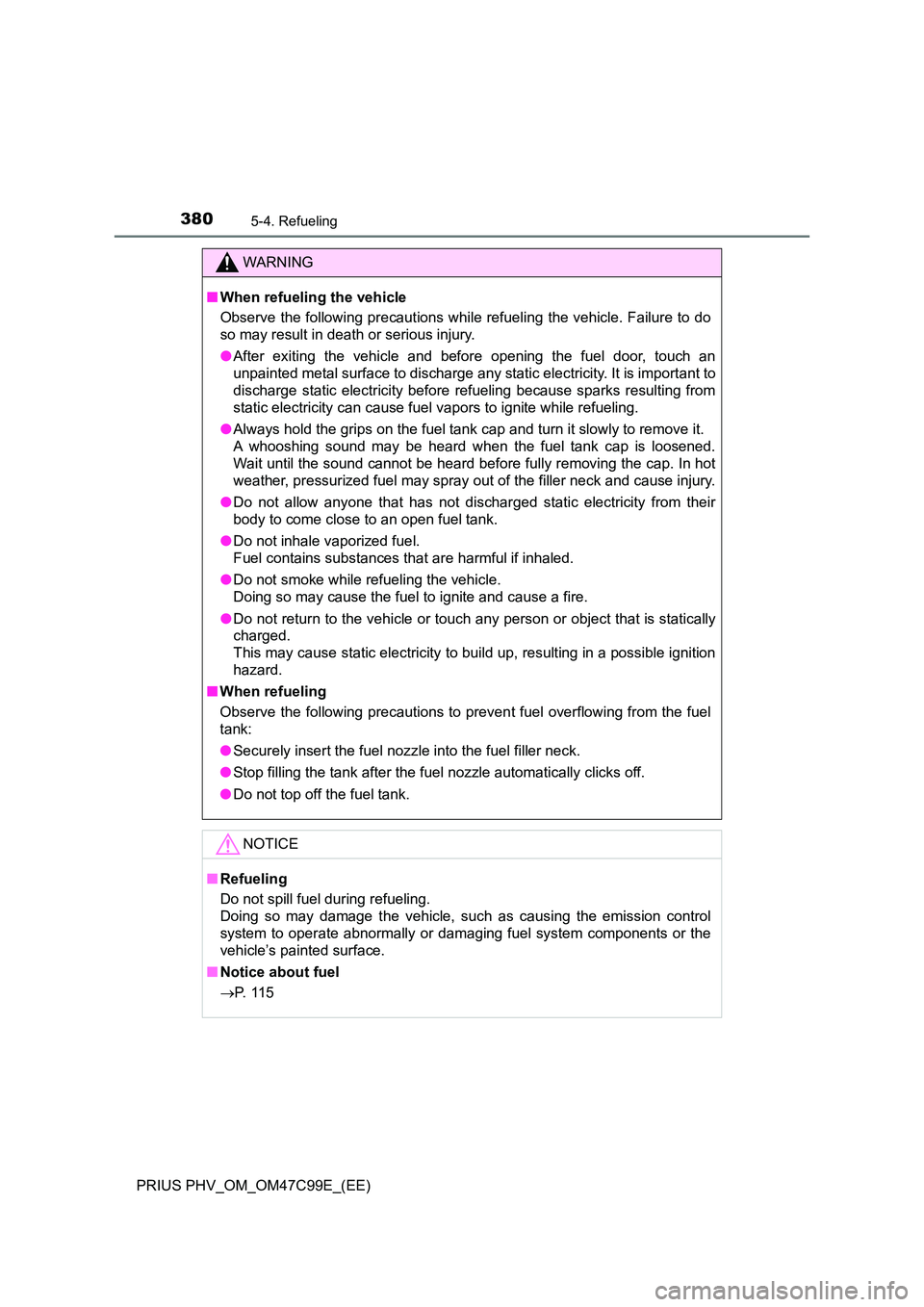
3805-4. Refueling
PRIUS PHV_OM_OM47C99E_(EE)
WARNING
■When refueling the vehicle
Observe the following precautions while refueling the vehicle. Failure to do
so may result in death or serious injury.
● After exiting the vehicle and before opening the fuel door, touch an
unpainted metal surface to discharge any stat ic electricity. It is important to
discharge static electricity before re fueling because sparks resulting from
static electricity can cause fuel vapors to ignite while refueling.
● Always hold the grips on the fuel tank cap and turn it slowly to remove it.
A whooshing sound may be heard when the fuel tank cap is loosened.
Wait until the sound cannot be heard before fully removing the cap. In hot
weather, pressurized fuel may spray out of the filler neck and cause injury.
● Do not allow anyone that has not discharged static electricity from their
body to come close to an open fuel tank.
● Do not inhale vaporized fuel.
Fuel contains substances that are harmful if inhaled.
● Do not smoke while refueling the vehicle.
Doing so may cause the fuel to ignite and cause a fire.
● Do not return to the vehicle or touch any person or object that is statically
charged.
This may cause static electricity to build up, resulting in a possible ignition
hazard.
■ When refueling
Observe the following precautions to pr event fuel overflowing from the fuel
tank:
● Securely insert the fuel nozzle into the fuel filler neck.
● Stop filling the tank after the fuel nozzle automatically clicks off.
● Do not top off the fuel tank.
NOTICE
■Refueling
Do not spill fuel during refueling.
Doing so may damage the vehicle, such as causing the emission control
system to operate abnormally or damaging fuel system components or the
vehicle’s painted surface.
■ Notice about fuel
P. 1 1 5